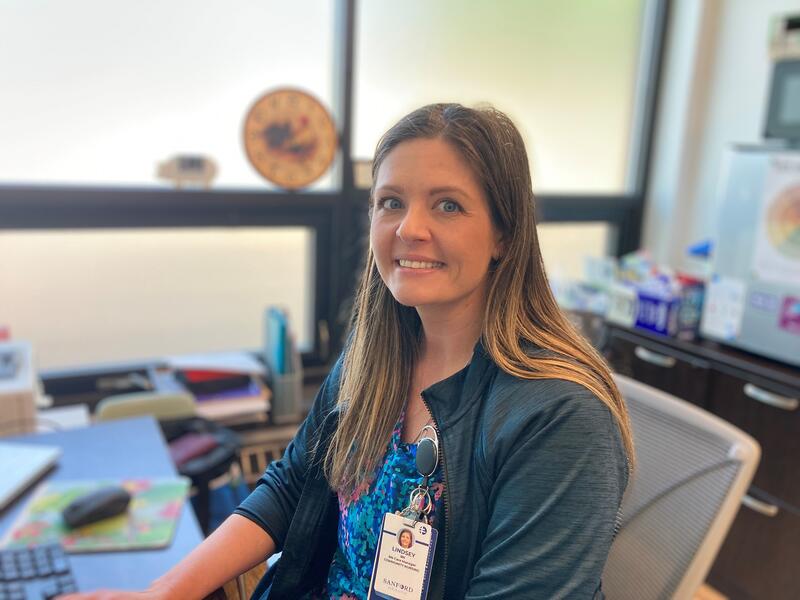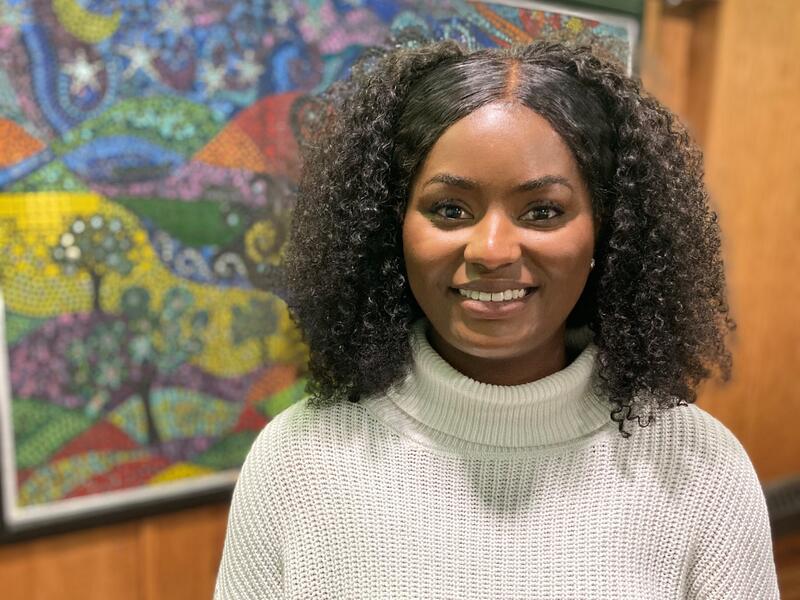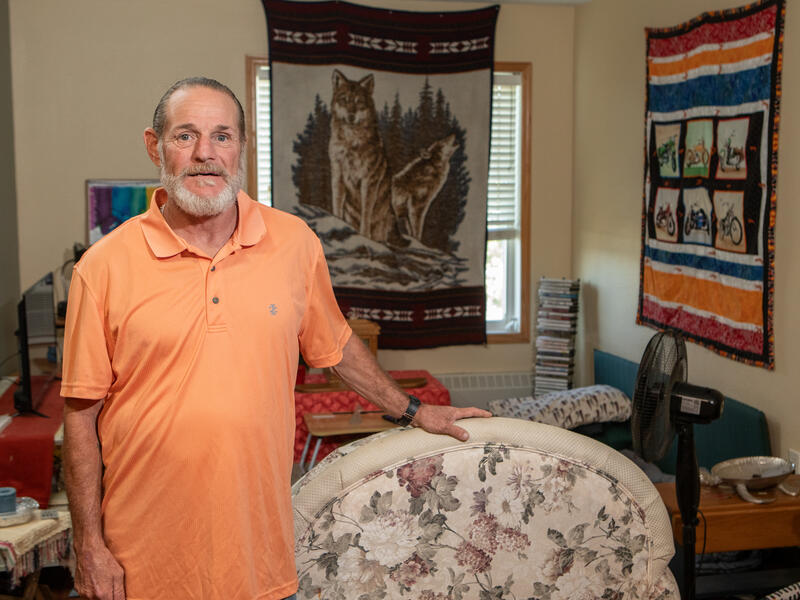“She’s not just a good nurse. She’s like a little angel.”
Those are the words Christopher Doss, 54, uses to describe Lindsey Zandonadi, the woman he says saved his life. Zandonadi first met Doss at Micah’s Mission emergency shelter in Moorhead, Minnesota, where she is a registered nurse care manager with Sanford Health. At that time, Doss was homeless and addicted to methamphetamine.
“I had gotten sick with pneumonia, and I’d been (at Micah’s Mission) for a few days. I was having symptoms of a heart failure and I didn’t know it,” Doss said. “I went in to see the nurse, Lindsey, and she told me that I should go to the hospital because I might be having congestive heart failure. She saved my life.”
Initially, Zandonadi checked his cough and cold symptoms.
“It kind of progressed from ‘we have some respiratory stuff going on, it’s been addressed, it’s not getting better,’” she said. “There were a few new symptoms. It just alerts you. Maybe there’s something else going on.”

Photo by Jason Anschutz, Sanford Health
Care in the community
The care Zandonadi provided to Doss, and others at Micah’s Mission, is part of a program set up by the Sanford Community Case Management team to give much-needed assistance to vulnerable residents in the Fargo-Moorhead area.
The National Low-Income Housing Coalition says that at any given time, there are approximately 1,000 individuals experiencing homelessness in the Fargo-Moorhead region. And the problem is growing. Calls from people at risk of being unhoused rose 65% from July 2022 to June 2023, according to Presentation Partners and FirstLink, who operate the Homelessness Crisis Line in the Fargo-Moorhead region.
This recent trend is part of the reason people like Zandonadi, and the Sanford program in general, are more important than ever.
“You’re really connecting on the ground with everyone,” Zandonadi said. “Sometimes you’re just starting from scratch, but there’s a lot of opportunity for education and making a big difference in getting people set up with what they need.”
Partnering with our communities: Sanford’s commitment to stronger, healthier community
Zandonadi is among a handful of nurses who provide care at places like Micah’s Mission and Bright Skies transitional apartment complex in Moorhead, the YWCA women’s and children’s shelter in Fargo, and the New Life male shelter in Fargo.
At these locations, RNs assist with everything from wound care and medication management to dietary needs and general education on medical diagnoses. Zandonadi also helps connect patients to Sanford doctors, and she advises patients like Doss on how to manage their own health care.
“The systems are hard to navigate, and people can get really down on themselves,” Zandonadi said. “We have a lot of people that are getting injured, falling off their bicycles. We get frostbite when it gets a little bit colder out.
“We can navigate it together and go through the steps and you can talk about it. So I think being in the shelter is important because I do get to see people walking around during the day. Having to physically go somewhere else is a little bit of a barrier for a lot of people. Especially when somebody doesn’t have money, and they don’t have their phone working and there’s all those other things going on.”
Meeting needs beyond the hospital
Chantal Kabwe is a housing support case manager at Micah’s Mission and Churches United. She has seen firsthand the impact nurses like Zandonadi have made on people at the shelter.
“It makes such a difference for Churches United as an agency where we are not sending a lot of our folks to the ER, but those needs that easily could be met are being met.”

Photo by Jason Anschutz, Sanford Health
In fact, it’s those smaller, more common diagnoses that make a big difference at Sanford as well. In the month of September alone, program estimates show it diverted 85 unnecessary ER trips, 14 hospital stays, 131 walk-in or urgent care visits and six ambulance calls. In short, the program saves both the hospital and these patients time and money, while also resulting in a less crowded emergency room.
“Somebody will come and cough and say I think I need to go to the ER,” Zandonadi said. “We’ll sit down and we’ll talk about symptoms and check blood pressure or check temperature and say you’re certainly free to go to the ER or walk-in urgent care, but this is what I’m seeing: your blood pressure looks OK. You don’t have a fever. Do you want to try cough medicine? Do you want to try increasing your fluids? Talking about those things, people sometimes will just feel less worried about it and will be OK with trying something else.”
Hope for the future
For Christopher Doss, a trip to the hospital was truly needed. Thanks to Zandonadi’s assessment, and the rapport the two had built together, Doss agreed to seek treatment at Sanford Health in Fargo where he was diagnosed with congestive heart failure. Doss quit using drugs, but a setback in his recovery caused even more damage.
“I was like six months clean and I relapsed and I had another heart failure, a heart attack,” Doss said. “My drug addiction that I have, I fight with it every day. It’s one day at a time, but it’s a deal where I can’t do it because, you know … if I do, I die.”
Doss is now two months clean and sober. His case manager is Chantal Kabwe, and with her help he is no longer homeless. In fact, he lives in an apartment with his girlfriend and their dog right next door to Micah’s Mission. So he can still see people like Zandonadi when he needs help with his next appointment. Sometimes he stops in just to say hello, which is important after his time living on the street.
“It was lonely being out there. I don’t have any family left. I’m on my own. I had a drug addiction, which nobody’s your friend. You can’t trust anybody,” Doss said. “My life’s just so much better. I see things different. I feel better. And I don’t want to live like that no more.”
That progress shows to Zandonadi as well.

Photo by Travis Jensen, Sanford Health
“He’s looking pretty good, and his self-confidence has gone up a lot,” she said. “He’s taking time to invest in himself and take care of himself and realizing that he’s important, and that if he wants to live a healthy life, that he’s got to change some of these things.”
For people who work in shelters every day like Zandonadi and Kabwe, Doss’ story is one of hope. It’s also a big reason why they do what they do: to help those in need and be an important link to a more secure life.
“All of us are like one step away from being in a situation like this,” Kabwe said. “So having that support system and the encouragement of the community showing up for them makes such a difference.”
Learn more
- Sanford Health connects patients to community resources
- Tiny house community puts roofs over homeless veterans
- Sanford report details pledge to patients, communities
…
Posted In Chemical Dependency, Community, Fargo, Here for all. Here for good., Nursing and Nursing Support
